Pterosaurs
Still Living


Would you like to know about those looking for
non-extinct pterodactyls? This is the place.
About us: Jonathan Whitcomb, Garth Guessman, David Woetzel, Paul Nation, and their associates
Garth Guessman
He explored remote islands in
Papua New Guinea on two
expeditions, searching for a
living pterosaur (including the
long-tailed featherless ropen).

The American cryptozoologists David Woetzel (top, second from
right) and Garth Guessman (kneeling on the right) became
friends with many natives on Umboi Island, Papua New
Guinea, during their ropen expedition in 2004
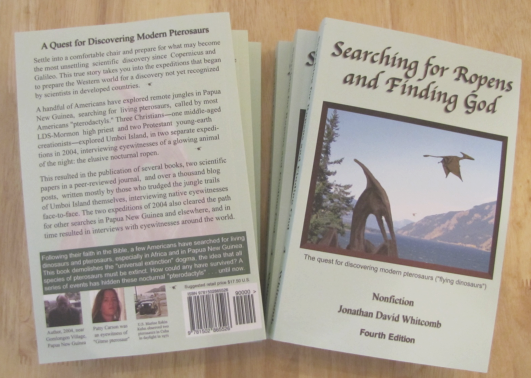
Searching for Ropens and Finding God could also be called “the Bible of modern
pterosaurs,” although most of the content is not about religion. This is a nonfiction
for people of all faiths, yet it is a cross genre: cryptozoology, spiritual, and true-
life adventure. It is now in its fourth expanded edition; get your own copy.

copyright 2017-2019 Jonathan David Whitcomb
Greg Hedger





Jonathan Whitcomb
This forensic videographer, originally
from Southern California, explored the
island of Umboi, Papua New Guinea,
in 2004, interviewing eyewitnesses of
the huge nocturnal ropen.
David Woetzel
(He’s seen here on an expedition in
Africa, searching for a living dinosaur.)
Woetzel and Guessman searched for
the ropen in 2004, on Umboi Island, a
few weeks after Whitcomb was there.
Paul Nation
This Texan has traveled to Papua
New Guinea, to search for living
pterosaurs, more often than any
other American: five times, and in
2006, he videotaped two indavas.

About Whitcomb
Jonathan David Whitcomb, before his expedition in Papua New
Guinea in 2004, was the kind of forensic videographer who made
settlement documentaries and day-in-the-life videos for attorney
firms (mostly in Southern California). He is the publisher of this
site (“Pterosaurs Still Living”) and is responsible for its content.
Since his expedition, he has written four nonfiction books on
these featherless flying creatures, and has published them in a
total of nine editions. He has also written the scientific paper
“Reports of Living Pterosaurs in the Southwest Pacific.”

About Paul Nation
On his first expedition in Papua New Guinea, in 1994, he accompanied the Biblical creationist Carl Baugh.
Paul was unsure, at first, of the reality of the ropen, by whatever name it was called in various areas and
islands of that tropical wilderness in the southwest Pacific. After hearing what many native eyewitnesses
said about the creature, however, he came to believe that a real animal was at the heart of these sightings,
an animal that somehow gave off a glow, apparently some kind of bioluminescence.
Paul led his own expedition on Umboi Island, in 2002, with his son Nathanael. They did not see the ropen
but were able to interview natives.
The 2006 expedition on the mainland of Papua New Guinea—that was different, for Paul was able to not
only observe a number of indava lights but he videotaped two of them. The video footage he brought back
to the United States was duplicated by Jonathan Whitcomb, and a copy was sent, via Garth Guessman, to
the physicist Clifford Paiva, who analyzed it. The two lights were found to be most unusual.
About Guessman and Woetzel
A few weeks after Whitcomb’s expedition on Umboi Island, in 2004, David Woetzel and Garth
Guessman took a flight there on a small plane from the mainland of Papua New Guinea. With
their native interpreter, Pastor Jacob Kepas, they then took a banana boat around the north-
east part of Umboi, stopping at small villages to interview islanders.
They eventually arrived on Mount Tolo, after Woetzel had a brief sighting of a flying light that
was heading toward that mountain. Unfortunately, the two American explorers had no clear
sighting of any form or feature of the flying creature that natives call ropen. They were able to
interview a number of important eyewitnesses, however, including Jonathan Ragu and Jonah
Jim. Both of those natives saw the ropen clearly enough to report the large wings and the long
tail of the ropen, and both eyewitnesses chose the same silhouette sketch from among dozens
of images of birds, bats, and pterosaurs: the Sordes pilosus, a Rhamphorhynchoid pterosaur.
Woetzel and Guessman also found large shells of giant clams, some of them far inland, and the
natives told them that the ropen carries them up away from the beach for feeding.
After that expedition in 2004, Guessman interviewed the eyewitness Duane Hodgkinson, a
World War II veteran who encountered a gigantic “pterodactyl” in New Guinea, south of the
island of Umboi, in 1944. That face-to-face interview was videotaped by Guessman and the
footage was edited by Whitcomb and published on Youtube. “Ropen-Pterodactyl American
Eyewitness” has been viewed over 344,000 times, as of late November of 2017.


Rex Yapi Epa
In recent years, Greg Hedger and Rex Yapi
Epa have played an important role in these
living-pterosaur investigations, especially
regarding the preparations for an expedition
on Umboi Island in late 2017 or early 2018.
Hedger has been of great help, through his
financial contributions and in promoting
awareness of the need for funding, in making
it possible for Rex to lead a major expedition
on Umboi. This will be a longer search for the
ropen than we have had in the past: It will
likely last many weeks.
Rex himself was an eyewitness of the ropen a
few years ago, as he and several others were
on a banana boat off the coast of Umboi.


Clifford Paiva
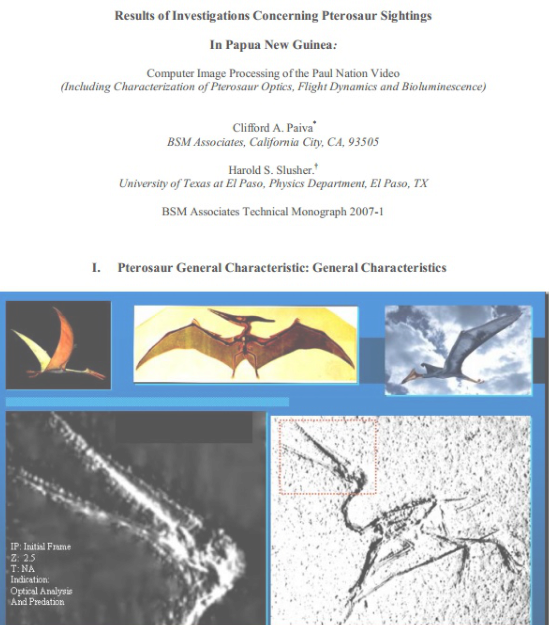


This missile defense physicist (BSM
Associates) has been a great help to our
investigations over many years. Clifford
Paiva wrote the scientific paper “Results
of Investigations Concerning Pterosaur
Sightings in Papua New Guinea” in 2007,
with help from a University of Texas at
El Paso professor: Harold Slusher. Much
of that scientific paper was from a deep
analysis of video footage recorded by the
cryptozoologist Paul Nation of Texas,
after his late-2006 expedition (on the
mainland of Papua New Guinea).
In more recent years, Cliff Paiva has carefully examined the old photograph
that is now called “Ptp.” In 2017, he and Jonathan Whitcomb agreed that this
photo likely has a genuine image of a modern pterosaur. In other words, these
two scientists have agreed that the preponderance of evidence supports this
idea: The photograph recorded a real extant pterosaur, having apparently
died just before (or it was in the process of dying). Late in 2018, however,
a complication arose: The origin of the wings was brought into question.
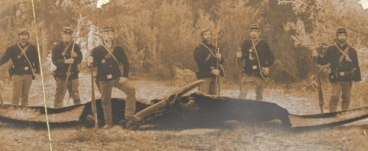
About the late Scott Norman
In a remote jungle in central Africa in 2001, Scott Norman (as part of an international team)
and his associates searched for what they believed was a living sauropod dinosaur. They had
little success, but they were able to talk with natives who knew about the Mokele-mbembe.
A few years later, Norman met with Jonathan Whitcomb and Garth Guessman, in Long Beach,
California, and heard what those “LP” cryptozoologists had learned about living pterosaurs.
In July of 2007, Norman took his turn watching the night sky, in central California, while his
cryptozoology associates Garth Guessman and David Woetzel took a break. Not expecting to
see anything unusual, he was surprised when a large Pteranodon-like creature flew over a
nearby shed. He estimated the wingspan at 8-10 feet, and it had bat-like wings.
Apparent Pteranodon sighting
Scott T. Norman (1964-2008)
Milt Marcy (left) and Peter Beach in southern Washington
About Marcy and Beach
In August of 2014, Jonathan Whitcomb interviewed Peter Beach and Milt
Marcy on the bank of a river, in southern Washington state, where those two
men had witnessed flying lights at night.
How do flying lights in the northwestern United States relate to non-extinct
pterosaurs? It’s not just in a speculation about a relationship to the glowing
ropen of Papua New Guinea. On the shore of that river in Washington, Milt
and Pete showed Jonathan the tree where a light had perched one night, and
another eyewitness, closer to sunrise, saw an apparent pterosaur—in that
same tree where the flying light had come to rest at night.


Jacob Kepas (left) and James Blume in 2004
These two men, the Baptist minister Jacob Kepas and the Baptist missionary
Jim Blume, have contributed much to living-pterosaur investigations. Blume
was interviewed twice by Garth Guessman: once in person, in the city of Lae,
Papua New Guinea in 2004 and once by phone years earlier. This missionary
has spoken with many natives who have knowledge of these flying creatures.
As a plane pilot, Blume has also helped get Biblical creationist explorers into
remote areas of tropical wilderness by flying Americans where they’ve needed
to go. This was especially important for Paul Nation, who otherwise would not
have been able to get to Tawa Village on the mainland (2006).
Jacob Kepas has seen these large flying creatures twice in his life: as a boy one
night in his village and in 2006. In the recent sighting, he was helping inter-
pret for Nation, and in that expedition Kepas saw what was most likely a big
indava that was sleeping in daylight on a cliff, deep in the mainland of PNG.
Kepas was also interviewed by Josh Gates during the Destination Truth TV-
production expedition in 2007, in another area of the mainland.
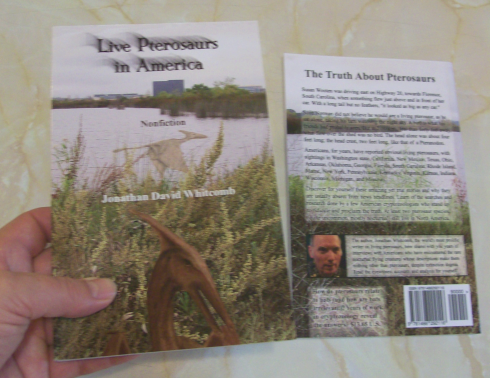
Live Pterosaurs in America, now in its third edition, was also written by Jonathan
Whitcomb. Unlike Searching for Ropens and Finding God, this nonfiction is more
strictly in cryptozoology genre. It’s mainly about sightings in the United States.
Regarding this “about us” page on living-pterosaur investigators
From the creator of “Pterosaurs Still Living” (of which this page is a small
part) Jonathan Whitcomb:
“This is not a complete listing of people who have searched for these extant
modern pterosaurs in various areas of the planet but a brief introduction to
twelve of the more prominent men who have been more active in the more
recent investigations. In other words, it introduces those explorers and
researchers who have been more consistently active and better known more
recently. In alphabetical order by surname they are Peter Beach, James (Jim)
Blume, Rex Yapi Epa, Garth Guessman, Greg Hedger, Jacob Kepas, Milt
Marcy, Paul Nation, the late Scott Norman, Clifford Paiva, me (Jonathan
Whitcomb), and David Woetzel.
“Please forgive me if I have overlooked an important explorer or a researcher
who has made an important contribution over the years. Some of them have
been less well known to me and others have desired to be anonymous, at least
originally. I am open to suggestions for future online publications.
“This page is not meant to even begin to introduce the sightings by countless
eyewitnesses. Shocking as it may appear to many Westerners, eyewitnesses of
obvious pterosaurs appear to number at least in the tens of thousands world-
wide. Indeed, the conservative estimate I have given for the number of persons
who’ve had some kind of encounter, at some time in their lives, with an extant
pterosaur, is between 7 million and 128 million, and it really is conservative.”
ver-042


Pterosaurs
Still Living
Would you like to know about those looking for
non-extinct pterodactyls? This is the place.
About us: Jonathan Whitcomb, Garth Guessman, David Woetzel,
Paul Nation, and their associates


Jonathan Whitcomb
This forensic videographer, originally
from Southern California, explored the
island of Umboi, Papua New Guinea,
in 2004, interviewing eyewitnesses of
the huge nocturnal ropen.
Paul Nation
This Texan has traveled to Papua
New Guinea, to search for living
pterosaurs, more often than any
other American: five times, and in
2006, he videotaped two indavas.
Garth Guessman
He explored remote islands in
Papua New Guinea on two
expeditions, searching for a
living pterosaur (including the
long-tailed featherless ropen).


David Woetzel
(He’s seen here on an expedition in
Africa, searching for a living dinosaur.)
Woetzel and Guessman searched for
the ropen in 2004, on Umboi Island, a
few weeks after Whitcomb was there.

The American cryptozoologists David Woetzel (top, second from
right) and Garth Guessman (kneeling on the right) became
friends with many natives on Umboi Island, Papua New
Guinea, during their ropen expedition in 2004
About Guessman and Woetzel
A few weeks after Whitcomb’s expedition on Umboi Island, in 2004, David
Woetzel and Garth Guessman took a flight there on a small plane from the
mainland of Papua New Guinea. With their native interpreter, Pastor Jacob
Kepas, they then took a banana boat around the north-east part of Umboi,
stopping at small villages to interview islanders.
They eventually arrived on Mount Tolo, after Woetzel had a brief sighting of
a flying light that was heading toward that mountain. Unfortunately, the two
American explorers had no clear sighting of any form or feature of the flying
creature that natives call ropen.
They were able to interview a number of important eyewitnesses, however,
including Jonathan Ragu and Jonah Jim. Both of those natives saw the ropen
clearly enough to report the large wings and the long tail of the ropen, and
both eyewitnesses chose the same silhouette sketch from among dozens of
images of birds, bats, and pterosaurs:
They both chose Sordes pilosus, a Rhamphorhynchoid pterosaur.
Woetzel and Guessman also found large shells of giant clams, some of them
far inland, and the natives told them that the ropen carries them up away
from the beach for feeding.
After that expedition in 2004, Guessman interviewed the eyewitness Duane
Hodgkinson, a World War II veteran who encountered a gigantic “pterodactyl”
in New Guinea, south of the island of Umboi, in 1944. That direct face-to-face
interview was videotaped by Guessman; the footage was edited by Whitcomb
and published on Youtube. “Ropen-Pterodactyl American Eyewitness” has
been viewed over 344,000 times, as of late November of 2017.


About Whitcomb
Jonathan David Whitcomb, before his expedition in Papua New
Guinea in 2004, was the kind of forensic videographer who made
settlement documentaries and day-in-the-life videos for attorney
firms (mostly in Southern California). He is the publisher of this
site (“Pterosaurs Still Living”) and is responsible for its content.
Since his expedition, he has written four nonfiction books on
these featherless flying creatures, and has published them in a
total of nine editions. He has also written the scientific paper
“Reports of Living Pterosaurs in the Southwest Pacific.”

About Paul Nation
On his first expedition in Papua New Guinea, in 1994, he accompanied the Biblical
creationist Carl Baugh. Paul was unsure, at first, of the reality of the ropen, by what-
ever name it was called in various areas and islands of that tropical wilderness in
the southwest Pacific. After hearing what many native eyewitnesses said about the
creature, however, he came to believe that a real animal was at the heart of these
sightings, an animal that somehow gave off a glow, some kind of bioluminescence.
Paul led his own expedition on Umboi Island, in 2002, with his son Nathanael.
They did not see the ropen but were able to interview natives.
The 2006 expedition on the mainland of Papua New Guinea—that was different,
for Paul was able to not only observe a number of indava lights but he videotaped
two of them. The video footage he brought back to the USA was duplicated by
Jonathan Whitcomb, and a copy was sent, via Garth Guessman, to the physicist
Clifford Paiva, who analyzed it. The two lights were found to be most unusual.
Greg Hedger


Rex Yapi Epa
In recent years, Greg Hedger and Rex Yapi Epa have played an important role in
these living-pterosaur investigations, especially regarding the preparations for an
expedition on Umboi Island in late 2017 or early 2018.
Hedger has been of great help, by his financial contributions and in promoting
awareness of the need for funding, in making it possible for Rex to lead a major
expedition on Umboi. This will be a longer search for the ropen than we have had
in the past: It will likely last many weeks.
Rex himself was an eyewitness of the ropen a few years ago, as he and several
others were on a banana boat off the coast of Umboi.


Clifford Paiva
This missile defense physicist (BSM
Associates) has been a great help to our
investigations over many years. Clifford
Paiva wrote the scientific paper “Results
of Investigations Concerning Pterosaur
Sightings in Papua New Guinea” in 2007,
with help from a University of Texas at
El Paso professor: Harold Slusher. Much
of that scientific paper was from a deep
analysis of video footage recorded by the
cryptozoologist Paul Nation of Texas,
after his late-2006 expedition (on the
mainland of Papua New Guinea).
In more recent years, Cliff Paiva has carefully examined the old photograph
that is now called “Ptp.” In 2017, he and Jonathan Whitcomb agreed that this
photo likely has a genuine image of a modern pterosaur. In other words, these
two scientists have agreed that the preponderance of evidence supports this
idea: The photograph recorded a real extant pterosaur, having apparently
died just before (or it was in the process of dying). Late in 2018, however,
a complication arose: The origin of the wings was brought into question.


About the late Scott Norman
In a remote jungle in central Africa in 2001, Scott Norman (as part of an international
team) and his associates searched for a living sauropod dinosaur. They had little suc-
cess, but they were able to talk with natives who knew about the Mokele-mbembe.
A few years later, Norman met with Jon Whitcomb and Garth Guessman, in Long
Beach, California, and heard what those “LP” cryptozoologists had learned about
living pterosaurs.
In July of 2007, Norman took his turn watching the night sky, in central California,
while his cryptozoology associates Garth Guessman and David Woetzel took a break.
Not expecting to see anything unusual, he was surprised when a large Pteranodon-
like creature flew over a nearby shed. He estimated the wingspan at 8-10 feet, and it
had bat-like wings.
Apparent Pteranodon sighting
Scott T. Norman (1964-2008)
copyright 2017-2019 Jonathan David Whitcomb

Milt Marcy (left) and Peter Beach in southern Washington
About Marcy and Beach
In August of 2014, Jonathan Whitcomb interviewed Peter Beach and Milt
Marcy on the bank of a river, in southern Washington state, where those two
men had witnessed flying lights at night.
How do flying lights in the northwestern United States relate to non-extinct
pterosaurs? It’s not just in a speculation about a relationship to the glowing
ropen of Papua New Guinea. On the shore of that river in Washington, Milt
and Pete showed Jonathan the tree where a light had perched one night, and
another eyewitness, closer to sunrise, saw an apparent pterosaur—in that
same tree where the flying light had come to rest at night.

Jacob Kepas (left) and James Blume in 2004
These two men, the Baptist minister Jacob Kepas and the Baptist missionary
Jim Blume, have contributed much to living-pterosaur investigations. Blume
was interviewed twice by Garth Guessman: once in person, in the city of Lae,
Papua New Guinea in 2004 and once by phone years earlier. This missionary
has spoken with many natives who have knowledge of these flying creatures.
As a plane pilot, Blume has also helped get Biblical creationist explorers into
remote areas of tropical wilderness by flying Americans where they’ve needed
to go. This was especially important for Paul Nation, who otherwise would not
have been able to get to Tawa Village on the mainland (2006).
Jacob Kepas has seen these large flying creatures twice in his life: as a boy one
night in his village and in 2006. In the recent sighting, he was helping inter-
pret for Nation, and in that expedition Kepas saw what was most likely a big
indava that was sleeping in daylight on a cliff, deep in the mainland of PNG.
Kepas was also interviewed by Josh Gates during the Destination Truth TV-
production expedition in 2007, in another area of the mainland.
Searching for Ropens and Finding God could also be called “the Bible of modern
pterosaurs,” although most of the content is not about religion. This is a nonfiction
for people of all faiths, yet it is a cross genre: cryptozoology, spiritual, and true-
life adventure. It is now in its fourth expanded edition; get your own copy.

Live Pterosaurs in America, now in its third edition, was also written by Jonathan
Whitcomb. Unlike Searching for Ropens and Finding God, this nonfiction is more
strictly in cryptozoology genre. It’s mainly about sightings in the United States.

Regarding this “about us” page on living-pterosaur investigators
From the creator of “Pterosaurs Still Living” (of which this page is a small
part) Jonathan Whitcomb:
“This is not a complete listing of people who have searched for these extant
modern pterosaurs in various areas of the planet but a brief introduction to
twelve of the more prominent men who have been more active in the more
recent investigations. In other words, it introduces those explorers and
researchers who have been more consistently active and better known more
recently. In alphabetical order by surname they are Peter Beach, James (Jim)
Blume, Rex Yapi Epa, Garth Guessman, Greg Hedger, Jacob Kepas, Milt
Marcy, Paul Nation, the late Scott Norman, Clifford Paiva, me (Jonathan
Whitcomb), and David Woetzel.
“Please forgive me if I have overlooked an important explorer or a researcher
who has made an important contribution over the years. Some of them have
been less well known to me and others have desired to be anonymous, at least
originally. I am open to suggestions for future online publications.
“This page is not meant to even begin to introduce the sightings by countless
eyewitnesses. Shocking as it may appear to many Westerners, eyewitnesses of
obvious pterosaurs appear to number at least in the tens of thousands world-
wide. Indeed, the conservative estimate I have given for the number of persons
who’ve had some kind of encounter, at some time in their lives, with an extant
pterosaur, is between 7 million and 128 million, and it really is conservative.”
ver-042


Pterosaurs
Still Living
Would you like to know about those looking for
non-extinct pterodactyls? This is the place.
About us: Jonathan Whitcomb, Garth Guessman,
David Woetzel, Paul Nation, and their associates

Jonathan Whitcomb
This forensic videographer, originally
from Southern California, explored the
island of Umboi, Papua New Guinea,
in 2004, interviewing eyewitnesses of
the huge nocturnal ropen.

Paul Nation
This Texan has traveled to Papua
New Guinea, to search for living
pterosaurs, more often than any
other American: five times, and in
2006, he videotaped two indavas.
Garth Guessman
He explored remote islands
in Papua New Guinea on
two expeditions, searching
for a living pterosaur (incl.
the long-tailed featherless
ropen).


David Woetzel
(He’s seen here on an expedition
in Africa, searching for a living
dinosaur.) Woetzel and Guessman
searched for the ropen in 2004, on
Umboi Island, a few weeks after
Whitcomb was there.

The American cryptozoologists David Woetzel (top, second
from right) and Garth Guessman (kneeling on the right)
became friends with many natives on Umboi Island,
Papua New Guinea, during their ropen expedition in 2004
About Guessman and Woetzel
A few weeks after Whitcomb’s expedition on Umboi Island, in
2004, David Woetzel and Garth Guessman took a flight there on
a small plane from the mainland of Papua New Guinea. With a
native interpreter, Pastor Jacob Kepas, they then took a banana
boat around the north-east part of Umboi, stopping at small
villages to interview islanders.
They eventually arrived on Mount Tolo, after Woetzel had a brief
sighting of a flying light that was heading toward that mountain.
Unfortunately, the two American explorers had no clear sighting
of any form or feature of the flying creature natives call ropen.
They were able to interview a number of important eyewitnesses,
however, including Jonathan Ragu and Jonah Jim. Both of those
natives saw the ropen clearly enough to report the large wings
and the long tail of the ropen, and both eyewitnesses chose the
same silhouette sketch from among dozens of images of birds,
bats, and pterosaurs:
They both chose Sordes pilosus, a Rhamphorhynchoid
(long-tailed) pterosaur.
Woetzel and Guessman also found large shells of giant clams,
some of them far inland, and the natives told them that the ropen
carries them up away from the beach for feeding.
After that expedition in 2004, Garth Guessman interviewed the
eyewitness Duane Hodgkinson, a World War II veteran who had
encountered a gigantic “pterodactyl” in New Guinea, south of the
island of Umboi, in 1944. That direct face-to-face interview was
videotaped by Guessman; the footage was edited by Whitcomb
and it was published on Youtube. “Ropen-Pterodactyl American
Eyewitness” has been viewed over 344,000 times, as of late
November of 2017.


About Whitcomb
Jonathan David Whitcomb, before his expedition in Papua New
Guinea in 2004, was the kind of forensic videographer who made
settlement documentaries and day-in-the-life videos for attorney
firms (mostly in Southern California). He is the publisher of this
site (“Pterosaurs Still Living”) and is responsible for its content.
Since his expedition, he has written four nonfiction books on
these featherless flying creatures, and has published them in a
total of nine editions. He has also written the scientific paper
“Reports of Living Pterosaurs in the Southwest Pacific.”

About Paul Nation
On his first expedition in Papua New Guinea, in 1994, he
accompanied the Biblical creationist Carl Baugh. Paul was
unsure, at first, of the reality of the ropen, by whatever
name it was called in various areas and islands of that
tropical wilderness in the southwest Pacific. After hearing
what many native eyewitnesses said about the creature,
however, he came to believe that a real animal was at the
heart of these sightings, an animal that somehow gave off
a glow, some kind of bioluminescence.
Paul led his own expedition on Umboi Island, in 2002,
with his son Nathanael. They did not see the ropen but
were able to interview natives.
The 2006 expedition on the mainland of Papua New
Guinea—that was different, for Paul was able to not only
observe a number of indava lights but he videotaped two
of them. The video footage he brought back to the USA
and was duplicated by Jonathan Whitcomb, and a copy
was sent, via Garth Guessman, to the physicist Clifford
Paiva, who analyzed it. The two lights were found to be
most unusual.

Rex Yapi Epa

In recent years, Greg Hedger and Rex Yapi Epa have played
an important role in these living-pterosaur investigations,
especially regarding the preparations for an expedition on
Umboi Island in late 2017 or early 2018.
Hedger has been of great help, by financial contributions
and in promoting awareness of the need for funding, in
making it possible for Rex to lead a major expedition on
Umboi. This will be a longer search for the ropen than we
have had in the past: It will likely last many weeks.
Rex himself was an eyewitness of the ropen a few years
ago, as he and several others were on a banana boat off the
coast of Umboi.
Greg Hedger

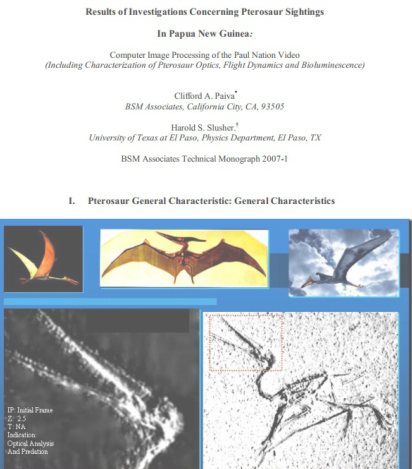

Clifford Paiva
This missile defense physicist (BSM Associates) has been a
great help to our investigations over many years. Clifford
Paiva wrote the scientific paper “Results of Investigations
Concerning Pterosaur Sightings in Papua New Guinea” in
2007, with help from a professor at the University of Texas
at El Paso: Harold Slusher. Much of that scientific paper
was from a deep analysis of video footage recorded by the
cryptozoologist Paul Nation of Texas, after his late-2006
expedition (on the mainland of Papua New Guinea).
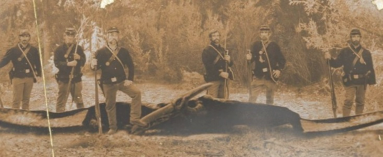
In more recent years, Cliff Paiva has carefully examined
the old photograph that is now called “Ptp.” In 2017, he
and Jonathan Whitcomb agreed that this photo likely
has a genuine image of a modern pterosaur. In other
words, these two scientists have agreed that the prepon-
derance of evidence supports this idea: The photograph
recorded a real extant pterosaur, having apparently
died just before (or it was in the process of dying); Late
in 2018, however, a complication arose: The origin of the
wings was brought into question.

Scott T. Norman (1964-2008)
About the late Scott Norman
In a remote jungle in central Africa in 2001, Scott
Norman (as part of an international team) and his
associates searched for a living sauropod dinosaur.
They had little success, but they were able to talk
with natives who knew about the Mokele-mbembe.
A few years later, Norman met with Jon Whitcomb
and Garth Guessman, in Long Beach, California, and
heard what those “LP” cryptozoologists had learned
about living pterosaurs.
In July of 2007, Norman took his turn watching the
night sky, in another part of California, while Garth
Guessman and David Woetzel, his cryptozoology
associates, took a break. Not expecting to see any-
thing unusual, he was surprised when a large
Pteranodon-like creature flew over a nearby shed.
He estimated the wingspan at 8-10 feet, and it
had bat-like wings.
Apparent Pteranodon sighting

Milt Marcy (left) and Peter Beach in southern Washington
About Marcy and Beach
In August of 2014, Jonathan Whitcomb interviewed Peter
Beach and Milt Marcy on the bank of a river, in southern
Washington state, where those two men had witnessed
flying lights at night.
How do flying lights in the northwestern United States re-
late to non-extinct pterosaurs? It’s not just in a speculation
about a relationship to the glowing ropen of Papua New
Guinea. On the shore of that river in Washington, Milt and
Pete showed Jonathan the tree where a light had perched
one night, and another eyewitness, closer to sunrise, saw
an apparent pterosaur—in that same tree where the
flying light had come to rest at night.

Jacob Kepas (left) and James Blume in 2004
These two men, the Baptist minister Jacob Kepas and
the Baptist missionary Jim Blume, have contributed
much to living-pterosaur investigations. Blume was
interviewed twice by Garth Guessman: once in person,
in the city of Lae, Papua New Guinea in 2004 and once
by phone years earlier. This missionary has spoken
with many natives who have knowledge of these flying
creatures.
As a plane pilot, Blume has also helped get Biblical
creationist explorers into remote areas of tropical
wilderness by flying Americans where they’ve needed
to go. This was especially important for Paul Nation,
who otherwise would not have been able to get to
Tawa Village on the mainland (2006).
Jacob Kepas has seen the large flying creatures twice
in his life: as a boy one night in his village and also in
2006. In the recent sighting, he was helping interpret
for Paul Nation, and in that expedition Kepas saw what
was probably a big indava that was sleeping in daylight
on a cliff, deep in the mainland of PNG.
Kepas was also interviewed by Josh Gates during the
Destination Truth TV-production expedition in 2007,
in another area of the mainland.
Searching for Ropens and Finding God could also be called “the
Bible of modern pterosaurs,” although most of the content is not
about religion. This is a nonfiction for people of all faiths, yet it is
a cross genre: cryptozoology, spiritual, and true-life adventure.
It is now in its fourth expanded edition; get your own copy.
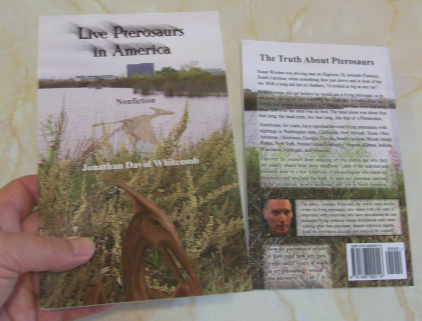
Live Pterosaurs in America, now in its third edition, was also
written by Jonathan Whitcomb. Unlike Searching for Ropens and
Finding God, this nonfiction is more strictly in cryptozoology
genre. It’s mainly about sightings in the United States.
copyright 2017-2019 Jonathan David Whitcomb
Regarding this “about us” page on
living-pterosaur investigators
From the creator of “Pterosaurs Still Living” (of which this
page is a small part) Jonathan Whitcomb:
“This is not a complete listing of people who have searched for
these extant modern pterosaurs in various areas of the planet
but a brief introduction to twelve of the more prominent men
who have been more active in the more recent investigations.
In other words, it introduces those explorers and researchers
who have been more consistently active and better known
more recently. In alphabetical order by surname they are Peter
Beach, James (Jim) Blume, Rex Yapi Epa, Garth Guessman,
Greg Hedger, Jacob Kepas, Milt Marcy, Paul Nation, the late
Scott Norman, Clifford Paiva, me (Jonathan Whitcomb), and
David Woetzel.
“Please forgive me if I have overlooked an important explorer
or a researcher who has made an important contribution over
the years. Some of them have been less well known to me and
others have desired to be anonymous, at least originally. I am
open to suggestions for future online publications.
“This page is not meant to even begin to introduce the sightings
by countless eyewitnesses. Shocking as it may appear to many
Westerners, eyewitnesses of obvious pterosaurs appear to
number at least in the tens of thousands world-wide. Indeed,
a conservative estimate I have given for the number of persons
who’ve had some kind of encounter, at some time in their lives,
with an extant pterosaur, is between 7 million and 128 million,
and that really is conservative.”
ver-042